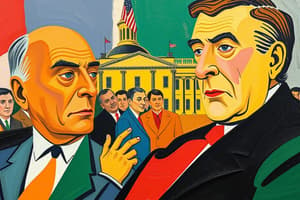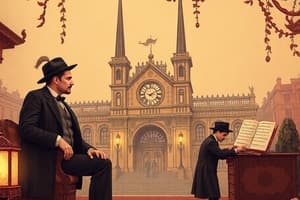Podcast
Questions and Answers
What was the main theme of Warren G. Harding's inaugural address?
What was the main theme of Warren G. Harding's inaugural address?
- A push for economic expansion
- A call for revolution
- An advocacy for globalism
- A return to normalcy (correct)
Which event contributed to the national instability before Harding took office?
Which event contributed to the national instability before Harding took office?
- The flu epidemic of 1918-1920 (correct)
- The Great Depression
- World War II
- The Civil Rights Movement
How did the American public generally respond to Harding's message?
How did the American public generally respond to Harding's message?
- With enthusiasm and acceptance (correct)
- With skepticism and doubt
- With resistance and protest
- With apathy and indifference
What major cultural changes characterized the 1920s in America?
What major cultural changes characterized the 1920s in America?
What phenomenon was noted in opposition to the cultural changes of the 1920s?
What phenomenon was noted in opposition to the cultural changes of the 1920s?
What was one of the consequences of the economic turmoil following World War I?
What was one of the consequences of the economic turmoil following World War I?
Which term was commonly used to refer to the decade of the 1920s in America?
Which term was commonly used to refer to the decade of the 1920s in America?
What was NOT a characteristic of the social environment in the 1920s?
What was NOT a characteristic of the social environment in the 1920s?
What significant action did Harding take to address the economy during his presidency?
What significant action did Harding take to address the economy during his presidency?
Which of the following individuals was NOT a part of Harding's administrative appointments?
Which of the following individuals was NOT a part of Harding's administrative appointments?
What was one of the consequences of the Teapot Dome scandal during Harding's presidency?
What was one of the consequences of the Teapot Dome scandal during Harding's presidency?
What was Calvin Coolidge's primary approach to economic policy?
What was Calvin Coolidge's primary approach to economic policy?
Which amendment granted women the right to vote in the United States?
Which amendment granted women the right to vote in the United States?
How did the labor movement fare during the 1920s?
How did the labor movement fare during the 1920s?
Which issue did many American women rally around in the 1920s after winning the vote?
Which issue did many American women rally around in the 1920s after winning the vote?
What was one of Calvin Coolidge's notable quotes regarding American business?
What was one of Calvin Coolidge's notable quotes regarding American business?
What reform measure aimed to eliminate legal distinctions based on sex?
What reform measure aimed to eliminate legal distinctions based on sex?
Which group suffered greatly from the corrupt practices of Harding's administration?
Which group suffered greatly from the corrupt practices of Harding's administration?
Flashcards are hidden until you start studying
Study Notes
Introduction to Warren G. Harding's Presidency
- Warren G. Harding became the 29th president of the United States on March 4, 1921, promising a "return to normalcy."
- Harding's inaugural address emphasized the need for healing and restoration after the turmoil of World War I and domestic unrest.
- Key events prior to Harding’s presidency included the loss of over 115,000 American soldiers in WWI, a flu epidemic killing nearly 700,000 Americans, and widespread labor strikes.
- The economic situation post-WWI saw unemployment rise to 20% and high bankruptcy rates among farmers.
- Despite his promises, Harding's presidency marked the beginning of the "Roaring Twenties," a decade characterized by significant cultural change and economic boom.
The Roaring Twenties
- The 1920s, known by various titles, including the Jazz Age and the Age of the Flapper, saw a shift in American lifestyles and values.
- Rapid advancements in mass production introduced automobiles, household appliances, and new forms of entertainment like talking films and jazz music.
- Cultural shifts led to more social freedom, including changes in gender roles symbolized by "the New Woman" and increased advocacy for African American rights represented by "the New Negro."
- The decade also experienced a backlash of conservative movements, such as the revival of the Ku Klux Klan and restrictive immigration policies.
Republican Governance (1921-1933)
- Harding’s administration focused on economic stability through high protective tariffs and reduction of wartime controls over industries.
- Post-war economic fears led to suppression of unions, with labor movements seeing significant decline and loss of public support.
- Harding's cabinet included notable figures like Henry C. Wallace (Agriculture) and Herbert Hoover (Commerce), but was marred by corruption involving the "Ohio gang."
The Teapot Dome Scandal
- A major scandal, the Teapot Dome, involved leasing government land to oil companies in exchange for bribes, leading to the resignation and imprisonment of key officials, including Interior Secretary Albert Fall.
- Harding's presidency faced scandal and pressure, leading to personal stress until his unexpected death in August 1923, after which Vice President Calvin Coolidge took office.
Calvin Coolidge's Presidency
- Calvin Coolidge, rising from local politics to the presidency, aimed to restore integrity while continuing Harding's pro-business policies.
- He infamously stated, “The chief business of the American people is business,” and favored tax reductions for wealthy Americans.
- Coolidge maintained high tariff rates and supported corporate interests, leading to critiques of his "active inactivity" as economic policy.
Activism in the 1920s
- The decade was also marked by significant activism, particularly among women, following the passage of the Nineteenth Amendment granting them the right to vote.
- Women campaigned for social reforms, including prohibition under the Eighteenth Amendment, and initiatives for child welfare and education.
- Alice Paul and the National Woman’s Party advocated for the Equal Rights Amendment, aiming to eliminate sex-based legal distinctions, though it faced defeat in Congress.
Studying That Suits You
Use AI to generate personalized quizzes and flashcards to suit your learning preferences.




